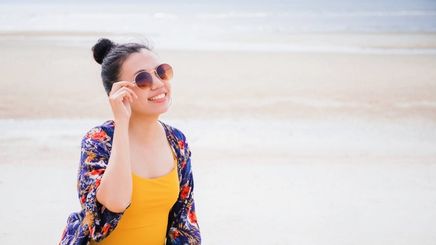
There’s a fine line between getting your dose of Vitamin D and getting sunburned by ultraviolet rays. These rays are part of the energy that comes from the sun, carrying ultraviolet radiation. Some UV radiation can penetrate the Earth’s surface — UVA and UVB rays — and both are not good for the skin. Ten to thirty minutes of sun each day is enough, or you’ll run the risk of sun damage. How exactly do UV rays damage your skin, and how can we protect ourselves from something we don’t always see?
How Can Ultraviolet Rays Damage Your Skin?
According to the Skin Cancer Foundation (SCF), prolonged exposure to UVA and UVB rays increases the risk of skin cancer. UVA has a shorter wavelength and is associated with , while UVB has a longer wavelength and is associated with skin burning. You wouldn’t want either, since they both damage the DNA in skin cells, leading to all sorts of problems, ranging from premature skin aging to mutations to skin cancer.
UVA vs. UVB: What’s the difference?
The SCF states that UV exposure is a powerful attack on the skin that can cause serious damage. One interesting fact is that this damage is cumulative and increases skin cancer risk over time. The degree of sun damage depends on how long your skin is exposed to the sun without protection and the intensity of UV rays. The sun is strongest between 10 a.m. to 4 p.m., in tropical climates and at high altitudes.
UVB rays penetrate the outer layer of the skin, causing tanning, sunburn, and blistering in extreme cases. UVB rays cannot penetrate glass. On the other hand, UVA rays are less intense than UVB rays but penetrate deeper into the skin and can cause genetic damage to cells. UVA makes up 95% of the radiation on Earth. It’s everywhere and can even .
How to Protect Yourself from UV Rays
Protecting yourself from the sun requires the combined effects of different healthy habits. Add these practices to your daily regimen to protect your skin from the harmful effects of .
1. Cover up with clothing.
If the temperature allows it, wear clothing that leaves as little exposed skin as possible. Tightly woven fabrics offer the best protection. You can also look for clothes that are specifically designed to block UV rays. These would usually have UPF on the label, which stands for Ultraviolet Protection Factor.
2. Draw the curtains of your windows.
Since UVA rays can penetrate windows, consider the amount of sunlight that comes into your house and imagine how much UVA enters along with it. If your windows allow for a lot of light to come in between 10 a.m. to 4 p.m., consider drawing the shades or rearranging furniture so that you are not directly exposed.
3. Wear hats when you're outdoors.
Here's the thing. The most a hat covers only a fraction of your skin, such as your face, ears, and neck. However, it does protect one part of your body that you rarely put sunscreen on – your scalp! The skin on your head can get sunburned, too. The sun can also damage your hair's cuticles.
4. Avoid the sun during peak hours.
In 2021, the Department of Science and Technology reported that one in 10 Filipino kids lacked vitamin D. Sun exposure does have merits – it's a free source of this helpful vitamin. According to numerous studies, the best time to absorb Vitamin D is between 10 a.m. to 3 p.m. However, this period is also when the sun shines the brightest. Soak up the sun's rays in the early hours of the morning instead. And don't forget step No. 5.
5. Wear SPF — all day, every day, everywhere, all over.
It takes something as simple and easy as applying sunscreen daily to protect your skin against harmful ultraviolet rays to prevent getting premature fine lines and wrinkles. It helps to understand what’s on the label.
SPF stands for Sun Protection Factor, and the number indicates how long it will take for you to get sunburn with the product versus without.
A product with SPF 30 means that if you apply it properly — which is generously and evenly — your skin is protected from the sun for up to 30 times longer than if you weren’t wearing any sunscreen. A product that says “broad spectrum” on the label means it protects against both UVB and UVA rays. A label that says “PA" stands for the Protection Grade of UVA rays. This is followed by a +, ++, or +++, which indicates how much protection it offers.
For extra protection daily, you can use POND’S Age Miracle Day Cream for protection from pollution and sun damage. This hardworking product also has Retinol-C Complex, which reduces fine lines while keeping the skin supple and moisturized. Apply it even when you’re working from home.
For overall moisturization and sun protection, apply a generous amount of Vaseline Healthy Bright Hand and Body Lotion. This sunscreen lotion hybrid offers protection against UVA and UVB rays with SPF24 PA++. It also evens out and smoothens the skin with . Don’t forget to reapply your sunscreen lotion every two hours!
Protection against ultraviolet rays should be a part of any skincare regimen. While the harmful effects of UVA and UVB rays can be scary, there’s no need to be afraid when you’re well-protected.